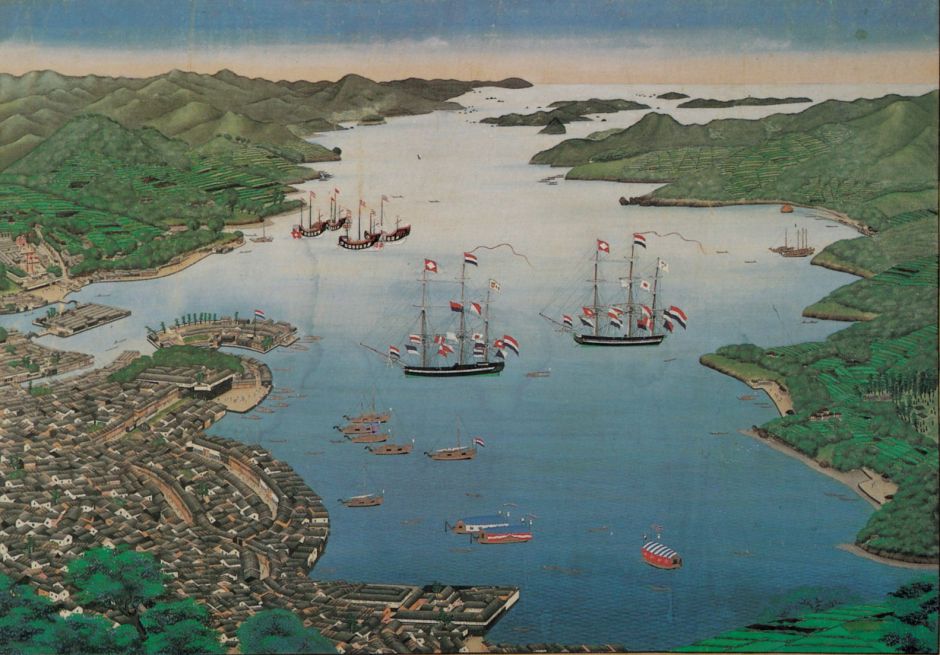As an archipelago, Japan has one of the longest coastlines in the world, almost thirty thousand kilometres (over 18,000 miles). One of its most popular stretches of coast is on Sagami Bay, to the south-west of Tokyo, where among the sandy beaches is the tiny island of Enoshima. The whole island is dedicated to the goddess of music and entertainment, Benzaiten (弁才天, 弁財天), and forms the subject for this article.

Painting the coast of Japan has always been popular, both in traditional style and technique, and in the Western styles which were slowly imported when the country was open to Western trade and influence. This grand ‘world view’ of Nagasaki was painted by one of the pioneers of Western technique, Kawahara Keiga (川原慶賀), in 1820. It was the port of Nagasaki which was the point of contact with the West, until the mid-nineteenth century.
Much of the art showing Enoshima has, of course, been in the form of ukiyo-e woodblock prints, rather than the fine art of painting. These became very popular in the first half of the nineteenth century, and went into decline after about 1860 – which was, ironically, when they started to become fashionable in Europe.

Kitagawa Utamaro’s (喜多川 歌麿) (c 1754-1806) Girl Fishers and Bathers, a triptych from 1791, shows seaside activities at Enoshima. Although composed as a triptych with a continuous motif, the same topless woman appears in each of the sheets, making the whole a multiplex narrative. Such narrative forms are common in traditional Japanese art.

Katsushika Hokusai (葛飾北斎) (1760–1849) is the most famous ukiyo-e artist in the West, thanks to a single image The Great Wave off Kanagawa. This print of Springtime in Enoshima from 1797 shows one variation of this famous view, with the small and densely-vegetated island of Enoshima at the end of its sand spit, and the snowy cone of Fuji in the far distance. Even on this beach, his waves look quite menacing.

Hokusai’s Enoshima in Sagami Province (c 1830) offers a more detailed view of the island, with people crossing the spit at low tide, and the ever-present Fuji in the distance.

Hokusai was also an accomplished painter: Shell Gathering is made in colour on silk, and has some quite Western touches in the clouds, for example.

Utagawa Hiroshige (歌川 広重) (1797–1858) was one of the last great Masters of ukiyo-e, and seems to have made many different prints of this section of the coast. The Seven-Ri Beach, from about 1835, views Enoshima and Fuji from the east, above the ‘Seven-Ri’ beach, and as with Hokusai invokes fearful waves.
Seven-Ri Beach, or Shichirigahama, is near Kamakura, which is a beautiful town filled with historical buildings and shrines, from its days as the capital of Japan.

Another of Hiroshige’s views of The Seven-Ri Beach, this from about 1858, gives a more classical account of Fuji.

Hiroshige’s triptych print of Pilgrimage of Female Entertainers to Enoshima to Pay Homage to Benzaiten (c 1835) is a wonderfully-detailed depiction of the pilgrimage to the island’s shrine, their figures crossing the spit to reach a rather grander version of the island.

Enoshima Seen from the Beach (1860), a diptych print, is unusual for cropping Fuji out. An elegantly-dressed man is riding an ox, which is being led by a woman. The waves are again quite threatening.

The Entrance Gate In Enoshima (c 1858), one of Hiroshige’s later prints, frames Fuji with a classical Japanese entrance gate on Enoshima.

My last print by Hiroshige shows the Entrance to the Cave at Enoshima Island in Sagami Province (1853), which remains popular with tourists today.

Utagawa Kuniyoshi (歌川 國芳) (1798–1861) was another of the last of the ukiyo-e Masters, whose style contrasts markedly with those of Hokusai and Hiroshige. The island is here shown in symbolic form, with Fuji in the distance.

With the decline of ukiyo-e in Japan, painting started to undergo change to adopt Western style, in the yōga movement. Among its early exponents is Takahashi Yuichi (高橋 由一) (1828-1894), who painted Enoshima at least twice: the view above is from 1873-76, and that below from 1876-77. Both adopt a low position on the sand spit, looking towards the island, with pilgrims, visitors, and others walking over to it.
Takahashi was largely self-taught; later yōga artists trained in France, but in his day there were very limited opportunities. With the Meiji Restoration, an Italian painter, Antonio Fontanesi, was appointed to advise the government, and Takahashi became professor of art at the Technical School of Fine Art. He was even made painter to the Imperial Court, and was permitted to paint the Emperor himself.

You can read more about the introduction of Western style into Japanese art in this series of articles.
If you’re hoping to attend any of the 2020 Summer Olympics in Tokyo, you’ll be pleased to know that Enoshima will be hosting its sailing and surfing events. I’m sure that Benzaiten will approve.

